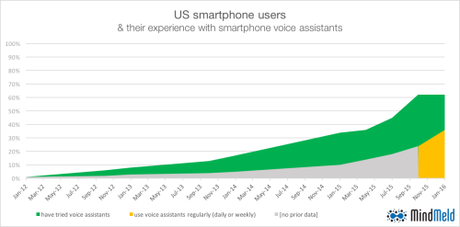
Today, MindMeld released " Intelligent Voice Assistants - Q1, 2016 User Adoption Survey." This quarterly report surveys users of smartphone intelligent voice assistants, such as Siri and OK Google, on the adoption, usage, and satisfiers and dissatisfiers of voice interfaces.
Key findings:
-
Mainstream adoption. 2015 appears to have been a tipping point in the adoption of intelligent voice assistants, based on adoption trends measured both this quarter and last. Whereas 61% of users had adopted intelligent voice assistants in the 12 months prior to October 2015, 44% of users had adopted them in the 12 months prior to January 2016. Amazon's Echo also showed signs of growth, with adoption doubling among survey respondents over the past quarter, albeit increasing from a small base of 2% to 4%.
-
Increased usage. 55% of voice assistant users use assistants regularly (daily or weekly). This is a substantial gain from the previous quarter, when 49% reported regular voice assistant use; this indicates not only mainstream adoption, but also greater engagement of users with voice assistants.
-
Overall satisfaction with experience. 48% of users report being satisfied with their voice assistants, despite sometimes recognizing areas for further improvement. Only 13% of users expressed dissatisfaction.
-
Desired natural language understanding. Basic speech recognition is one of the primary areas voice assistant users would like to see improved. While speech recognition does keep getting better, 44% of users report that there is still something to be desired, which is consistent with last quarter's results. This quarter, however, more users report desiring improvements in natural language understanding and search accuracy, with a 1% growth over last quarter's respective 28% and 27% percentages. This suggests that as assistants incorporate more natural language features, users start to expect more of this capability. 72% of users predict they would engage more with voice assistants if these improvements were made.
-
Home adoption. People most commonly use voice assistants in the home (43%, vs. 36% for in automobiles). The most compelling use case is also in a hands-free environment, so users can multitask. As such, MindMeld predicts there will be a pull for more home-based devices and applications, similar to Amazon Echo, but also voice enablement of other connected home appliances and devices.
-
App integration. Voice users demonstrate much higher use of different types of apps (~2x as much as non voice users). Users are also desirous of having voice capabilities on different apps. Music apps rank the highest, with 50% of music app users wanting voice enablement of music apps. More than 40% of users want voice with other types of apps, including shopping, travel, video, and local services apps.
To view all survey findings, visit http://info.mindmeld.com/survey2016q1.html
